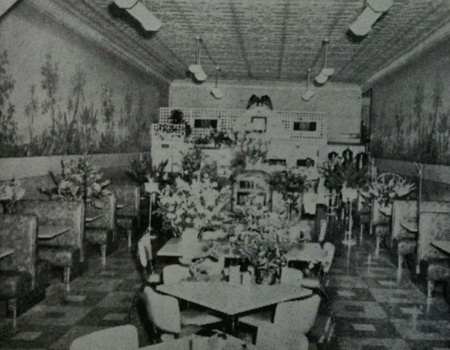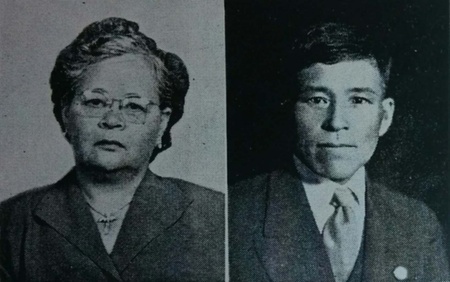Nebraska
Nebraska is a state with many plains and fertile soil, suitable for agriculture and livestock farming. The main industry is agriculture, with a wide variety of crops including grains, fruits, vegetables, sugar beets, and pasture grass, and the state is also known for its horses. Manufacturing is thriving in the state capital, Omaha.
The first large-scale Japanese immigrants to the state were in 1904, when Okajima Kaneya sent about 120 people to work in a cannery in Omaha.
Other immigrants were sent in groups along the UP and Burlington Railroad lines, where they later worked on nearby farms, some of them settling down as farmers.
As for commercial businesses, there were people who opened hotels, Western restaurants, and Japanese art and goods stores early on in Omaha, North Platte, and Scatch Bluff. Among them, representative stores that continued into the 1960s include the Oriental Trading Company in Omaha, the Palace Hotel in North Platte, and the Eagle Cafe in Scatch Bluff.
In addition, Japanese students have been studying at Lincoln University for a long time.
Marriage between whites and Japanese people is prohibited
The population of Japanese people in Nebraska was 2 in 1900, 590 in 1910, 804 in 1920, 647 in 1930, 480 in 1940, 619 in 1950, and 905 in 1960. (From the census)
The "Centennial History" records the history of Japanese Americans in each region of the state.
In the city of Omaha, there is an interesting description:
"Even today, Nebraska state law prohibits marriage between whites and Japanese people, but during the war, like other states, they were subject to various restrictions as wartime enemy citizens, and there was no exclusion whatsoever."
The Scutch Bluff region was a small village in the northwest of Nebraska, but in 1904, Shinzo Tanaka, a native of Yamaguchi Prefecture, was the first person to work on a radish farm. By 1910, the area had more than 200 residents.
Additionally, the Eagle Cafe is a famous Western restaurant that has had the best reputation in western Nebraska since its founder's time.
In and around Lexington, 130 miles west of Omaha, there were once 200 Japanese residents around 1905. Since then, the Kanda Brothers Farm has been a large-scale operation.
In Grand Island, the largest town in Hall County, Hiroshima-born Saburo Shindo opened a successful Paris Coffee shop on the city's main street in 1909. Employing 20 Japanese and five white students, daily sales were said to be at least $120.
Japanese communities desperately fought against anti-Japanese sentiment
The introduction to Nebraska in "Centennial History" summarizes the anti-Japanese issue that arose around 1920. Influenced by California's anti-Japanese land laws, a bill was submitted to the Nebraska state legislature to "prohibit foreigners from owning land and limit land leases to one year." With the economic boom after World War I, there were 700 Japanese people in the state at the time, but their success in agriculture, commerce, and other fields seems to have attracted resentment.
The Japanese community worked hard to prevent the bill from passing, including asking the Rev. Hisanori Kano, who was respected by white people at the time, to take measures. The bill was initially removed from the agenda, but then a similar bill was introduced to ban land leasing, and the issue flared up again.
The Japanese in the state further united and formed the "Ningzhou Japanese Awareness Association" to fight back. They continued their campaign with the help of influential people such as the governor. This issue became known throughout the United States, and with the support of pro-Japanese people, the bill was eventually passed in a way that was favorable to the Japanese.
* * * * *
New Mexico
It all started with mining
New Mexico is located south of Colorado, bordered by Kansas and Oklahoma to the east, Arizona to the west, and most of Texas, the western half of which borders Mexico. The entire state is a highland region.
The history of Japanese people in New Mexico began with mining, followed by railroad work, and much later, they settled as farmers. After the war, both mining and railroad work almost disappeared, and the only remaining farms were a few in the Messiah region near El Paso and near Albuquerque, and a few large farms in the eastern part of the state, in Lovington.
During the Pacific War, a family camp for the internment of Japanese Americans was built on the outskirts of Santa Fe in the northeast of the state, and many influential members of the Japanese American community were interned there.
From around 1907, many Japanese workers came to work as coal miners, mainly in the city of Gallup in the west, and at one point their numbers reached 300-400 around 1910. In addition, Japanese worked in coal mines such as Gibson, Weaver, Heaton, Navajo, and Clarkebury, all of which were owned by the American Ferry Company.
These were supplied starting in 1895, with Osaka native Nakanishi Masatomo as the boss. The jobs that the Japanese were primarily engaged in were coal mining and various other day labor jobs, where the coal miners were paid based on the amount of coal extracted, and the day laborers were paid based on ten hours of work.
At the Van Houten coal mine, in addition to Japanese people there were people of various other races, and it is said that "the majority of the workers were black, followed by Greeks, Italians, and Mexicans, and there was almost no prejudice or contempt for the Japanese."
Japanese farmers make a big success in Messiah, Donyana region
In terms of agriculture, Maxwell City in the northern Central Plain was a suitable place for sugar beets and welcomed Japanese farmers. In Lakewood in the southern Beechwood Plain, Kiyonokuni Kawamoto (from Wakayama Prefecture), who supplied workers to the coal mines, and others jointly purchased land on the outskirts and established a colony.
Above, I have introduced some interesting points from the overview in the "Centennial History," but the book then traces the footsteps of Japanese Americans by region, including Albuquerque and its suburbs, the Gallup area, the Messiah area, and other areas.
In Albuquerque, Japanese people first came to the suburb of Belen, where they worked as laborers for the Santa Fe Railroad, but then people who had left railroad work began to live there.
In the Messiah and Doniyana areas in the southern part of the state, Japanese farmers, although few in number, have been very successful.
"When Nakayama Kaichiro (Toyama) and his family immigrated to Doniyana from Nebraska in 1918, the land was mostly desert covered with sagebrush. White people were migrating in droves from all over the Southeast, and Nakayama was the first Japanese to settle there. Initially, they cultivated sugar beets and vegetables, and by 1923 they already owned 30 acres of land and managed 150 acres of rented land. From that time on, they also cultivated cantaloupe. Since then, they struggled while raising their children, and continued to farm proudly among the white farmers, solidifying their foundations. Nakayama passed away in the end of 1942, and his family, who took over his business, currently own and cultivate approximately 500 acres of land."
A representative example is given.
The "Centennial History" devotes 12 pages to introducing Japanese people in New Mexico, with two of those pages dedicated to a unique character story. Under the headline "50 years working on the railroad, raising the reputation of Japanese people: Gallup's Kimura Genta," the book describes the achievements of Kimura Genta, a native of Kumamoto Prefecture who came to the U.S. in 1900 at the age of 19.
After landing in San Francisco, Kimura is recommended by the owner of an inn to work on the railroad in Arizona. He finally makes it there without even knowing where Arizona is, but he doesn't understand a word of English, is ridiculed as a Jap, and is eventually fired.
This is where the story begins. However, he did not give up and returned to work for the railroad, and his work was recognized, leading to him becoming the railroad inspector for the town of Gallup. Around this time, there was a strike on the railroad against the hiring of Japanese people, but Kimura's efforts put an end to it.
After the war broke out, the company protected Japanese railway employees, including Kimura, against the movement to expel the Japanese. Here too, Kimura's presence was significant. The 100-year history states:
"Starting out as an apprentice railroad worker, Mr. Kimura served the company for 46 years, until he retired at an old age in 1946, with honesty and diligence. He earned the immense trust of his company and American society, and twice defied white unions to show that 'Japanese people are here,' and to promote the achievements of the Yamato people. There are few people like him."
The number of Japanese people in New Mexico increased from 8 in 1900 to 249 in 1930 and 930 in 1960 (according to the census).
(Note: I have used the original text as much as possible, but have made some edits. Titles have been omitted.)
*Next time we will introduce " Japanese people in Texas ."
© 2015 Ryusuke Kawai








